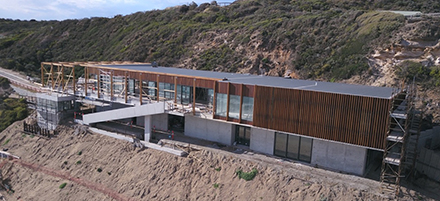
In 1960, the original Portsea Surf Life Saving Clubhouse in Victoria was constructed from a packing crate. Now, more than 60 years later, it has been transformed into a once-in a generation clubhouse. Situated right along the beach, this $9 million project required a full demolition and rebuild that has taken more than two years. Source: Timberbiz
Built by Ireland Brown Constructions, the clubhouse sits in what is arguably one of the most unforgiving environments in Australia. They required a superior timber that could withstand salt, water and wind. The specifications of the design and extreme weather conditions called for large, commercial grade Blackbutt timber, renowned for its durability and modern look.
Timber is the real highlight of this building. Blackbutt battens, hand cut from Boral Blackbutt F27 timber (supplied by Bayswater Timber), wrap around the entire façade. Bowens’ Commercial Development Manager, Danny Lamb managed the project and was on site weekly.
“It looks like the old bunkers that protected the coastlines in the past,” Mr Lamb said. “When the public see this, they’ll be amazed at the textures and colours that natural timber brings to this project.”
The Portsea Surf Lifesaving Club was determined to showcase quality Australian wood species. Boral worked closely with timber seller, Bowens, in providing all the timber decking and beams required for this mammoth project.
“They needed a very large quantity of quality Blackbutt, which we were able to deliver from Melbourne to the Bowens warehouse in Hastings without any hitches,” area manager for Boral Chris Mooney, said.
“When they ran out of timber during the project, we were able to deliver more product straight to the site.”
The pergola is also constructed from Blackbutt battens and features enormous laminated Blackbutt beams overhead. The beams are made from Class 1 durable timber compliable with the bushfire BAL- 29 requirement.
The clubhouse is uniquely located on cliff face of Mt Levy Beach, better known as Portsea Back Beach. This distinctive location wasn’t without its challenges, as access to the cliff was limited and uneasy. There was only a single, and extremely steep ramp leading to the site.
“Deliveries to site were tough,” Mike Bullows, site manager from Ireland Brown Constructions said.
“We had very limited access down to the beach, so we had to coordinate different-sized trucks just to be able to fit down the road.”





